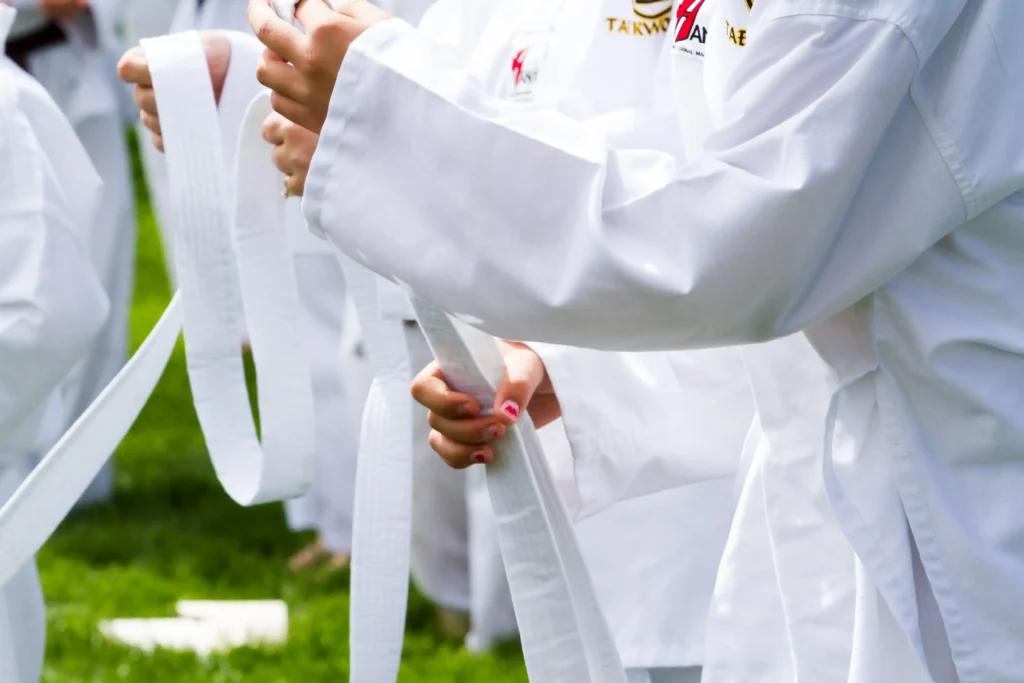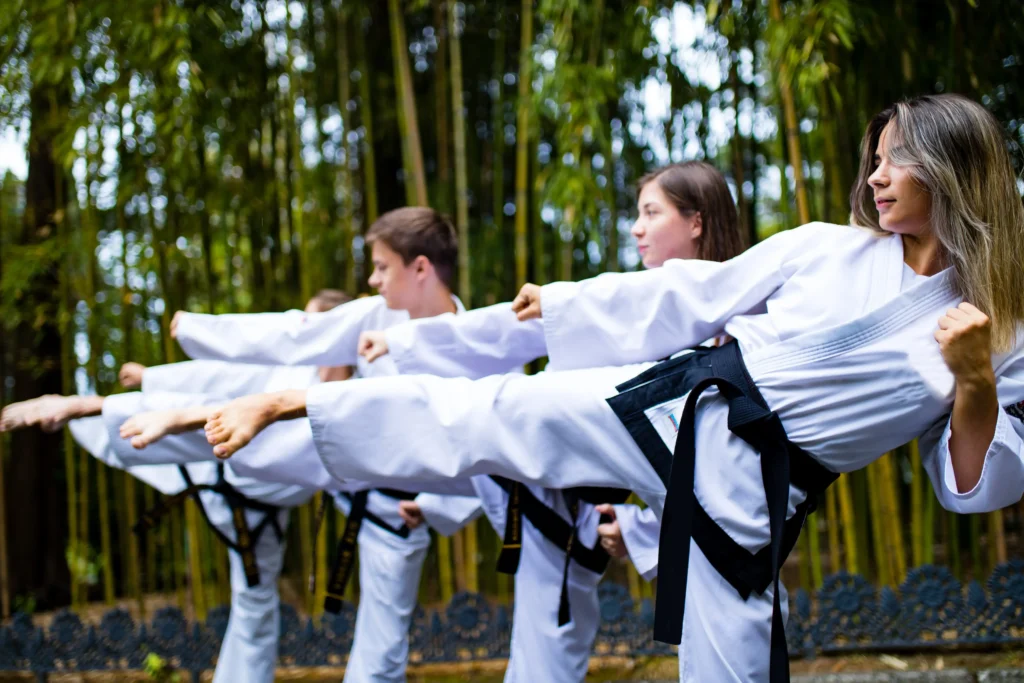Boxing and taekwondo are both powerful martial arts, but which one should you pursue? If you want to defend yourself, compete, or improve your fitness, which one is effective?
Boxing is all about punches, while Taekwondo focuses on kicks, but it goes deeper than that. You might wonder about the physical demands of each, the risk of injuries, and how the techniques work in a real-world scenario.
Here I’ll try to share a simple comparison that and include training methods and mental discipline. You can understand both arts and how each can fit into your personal goals. Let’s start!
Table of Contents
What is Boxing?
Boxing is a combat sport and its roots stretch back to ancient civilizations. The sport evolved over centuries. The significant developments were in 18th-century England. The Marquess of Queensberry Rules were established in 1867, and introduced gloves and structured rounds.

Core Philosophy
Boxing emphasizes discipline, strategy, and mental resilience. Success in boxing requires physical strength and the ability to outthink and outmaneuver an opponent.
Primary Techniques
- Punches: The main strikes in boxing include the jab, cross, hook, and uppercut. Each serves a specific purpose, like set up attacks and deliver knockout blows.
- Footwork: The movement is crucial. Boxers use footwork techniques to maintain distance, create angles, and position themselves.
- Defense: Defensive skills like slipping, bobbing, blocking, and clinching are must to avoid incoming punches and counterattac.
Typical Training Elements
- Conditioning: Boxers engage in cardiovascular and strength training to build endurance and power.
- Bag Work: Heavy bag and speed bag exercises help develop punching power, speed, and rhythm.
- Sparring: Controlled practice bouts help fighters to apply techniques in real scenarios, and improve timing and adaptability.
- Shadowboxing: The solo practice helps refine movement, form, and technique without a partner.
Competitive Aspects
Boxing matches are structured into 3-minute rounds. There is a minute rest in between. Fighters aim to win by knockout, technical knockout, or outscoring their opponent through strikes and defense. There are sanctioning bodies, and set of rules and championship titles.
What is Taekwondo?
Taekwondo is a Korean martial art and it evolved from traditional practices like taekkyeon and subak. Its name “tae” (foot), “kwon” (hand), and “do” (way) shows the focus on powerful kicks and hand strikes. It’s good for both self-defense and personal development.

Core Philosophy
Taekwondo emphasizes five tenets: courtesy, integrity, perseverance, self-control, and indomitable spirit. The art also draws from the Hwarang spirit. It is an elite warrior code from the Silla kingdom, and promote values like loyalty and courage.
Primary Techniques
- Kicks: Taekwondo is renowned for its dynamic kicks. They include front, side, roundhouse, back, and spinning kicks for speed and precision.
- Hand Strikes: Kicks are central, but hand techniques such as punches, blocks, and knife-hand strikes are integral for defense and offense.
- Forms (Poomsae): Structured patterns of movements that simulate combat scenarios. They help practitioners develop technique, balance, and focus.
Training Elements
Training in Taekwondo includes:
- Poomsae Practice: Repetitive practice of forms to improve technique and focus.
- Sparring (Kyorugi): Controlled combat with an opponent, for timing, distance, and strategy.
- Breaking Techniques (Gyeokpa): Show power and precision by breaking boards or other materials.
- Self-Defense Techniques: Applications of Taekwondo principles for real-world situations.
Competitive Aspects
Taekwondo competitions are categorized into:
- Sparring: Point-based matches. The competitors score by landing controlled kicks and punches on their opponent.
- Poomsae: Judged performances of forms. It assesses accuracy, power, and presentation.
Olympic Taekwondo, governed by World Taekwondo (WT), follows specific rules and scoring systems. Other organizations, like the International Taekwondo Federation (ITF), may have different approaches and rulesets.
Boxing vs. Taekwondo
| Aspect | Boxing | Taekwondo |
| Uniforms | Boxers wear shorts, gloves, and protective gear like headgear and mouthguards. | Practitioners wear a dobok (uniform) and protective gear. The belt indicates rank. |
| Techniques and Striking Focus | Emphasis on punches (jab, cross, hook, uppercut) and defensive movements like slipping and weaving. | Focus on high, fast kicks (e.g., roundhouse, spinning) and hand strikes. |
| Footwork and Range | Close to mid-range. Footwork is must for positioning and evasion. | Dynamic movement. The range varies from close to long-distance. |
| Guarding and Evasion | High guard for protection. Evasion through head movement and footwork. | Low guard. Evasion involves quick footwork and head movement. |
| Training Methodologies | Intense cardio, strength conditioning, shadowboxing, heavy bag work, and sparring. | Includes poomsae (forms), sparring, breaking techniques, and focus on flexibility. |
| Sparring Intensity | Full-contact sparring is common, focus on realistic combat scenarios. | Sparring varies. Olympic-style is full-contact, and traditional may be light-contact. |
| Discipline and Progression | Structured progression through weight classes and skill levels. Need mental toughness. | Ranked by colored belts. Strong focus on respect, courtesy, and personal development. |
| Self-Defense Effectiveness | Highly effective in close combat situations. Punching power and head movement are practical for real-world defense. | Effective, if there’s distance between the practitioner and the attacker. The emphasis on kicks might leave you vulnerable in close quarters. |
| Injury Risk | High risk of head injuries, concussions and potential long-term brain damage. Acute injury rate of 2.0 per 1,000 hours of participation. | Common injuries can be sprains, strains, and contusions, during high-contact sparring. |
| Physical Benefits | Improves cardiovascular health, endurance, strength, and coordination. | Better flexibility, balance, cardiovascular health, and overall physical fitness. |
| Mental Benefits | Mental toughness, focus, and stress relief. | Discipline, respect, and mental resilience. |
| Drawbacks | High risk of brain injuries, including chronic traumatic encephalopathy (CTE) | Potential for injuries due to high-impact kicks. Time commitment to master techniques. |

As I’ve already discussed the training elements and techniques, let’s move on to rules, regulations, and which one is better in specific scenarios.
The Difference in Rules
Boxing and Taekwondo differ in their competition rules. And it shapes how practitioners train and fight.
Boxing Rules:
- Strikes: Only punches with the knuckles of a closed fist are allowed.
- Target Areas: Strikes must land above the waist, and avoid the back, kidneys, and below the belt.
- Rounds: Matches consist of 3-minute rounds, with 9 to 12 rounds in professional bouts.
- Protective Gear: Boxers wear 10 to 16-ounce gloves, hand wraps, and mouthguards.
- Scoring: Judges award points based on clean, effective punches.
- Penalties: Fouls such as low blows, holding, or hitting with the back of the head can lead to warnings, point deductions, or disqualification.
Taekwondo Rules:
- Strikes: More focus on kicks. Punches are permitted.
- Target Areas: In Olympic Taekwondo, valid strikes include the head, trunk, and punches to the body.
- Rounds: Matches consist of 3 rounds, each 2 minutes long.
- Protective Gear: Competitors wear headgear, gloves, shin guards, forearm protectors, and a chest protector.
- Scoring: Points are awarded for controlled, accurate strikes, with electronic scoring systems often in use.
- Penalties: Excessive contact or illegal techniques can result in warnings or disqualification.

Which is Better for Self Defense?
Boxing is about powerful punches, head movement, and footwork. They deliver quick, accurate strikes, which are good in street fights. The defensive techniques, such as slipping and bobbing, allow them to evade attacks.
Taekwondo practitioners are trained in high, fast kicks, and dynamic footwork, and they can maintain distance from an opponent. The art also includes joint locks, throws, and pressure point techniques. It is a versatile skill set for self-defense.
In practical scenarios, a boxer may struggle to close the distance against a skilled Taekwondo practitioner. But, if the boxer can close the gap, their powerful punches can be decisive.
Boxing vs. Taekwondo For MMA
Boxing is integral to MMA due to effective striking, head movement, and footwork. Boxers’ ability to deliver powerful punches and maintain defensive posture helps their performance in the octagon.
Taekwondo adds dynamic kicking techniques to an MMA fighter’s arsenal. The high, fast kicks can be advantageous, but it requires adaptation to the MMA context.
Can a Taekwondo Guy Beat a Boxer?
A taekwondo practitioner can defeat a boxer, but several factors can influence it. Taekwondo can help maintain distance and deliver powerful blows. However, boxers excel in close-range combat, with superior head movement, footwork, and hand strikes,
If the distance is closed, the boxer will have an edge. The fight’s environment also matters. In a controlled setting with space to maneuver, a Taekwondo practitioner can use kicking techniques better than in confined spaces or street scenarios.
So, the outcome depends on the fighters’ adaptability, experience, and ability to exploit their opponent’s weaknesses.

Which is Harder to Learn: Boxing or Taekwondo?
Any martial art demands your time and dedication. The difficulty of learning depends on your natural aptitude, commitment, and the quality of instruction.
Boxing
- Boxing is relatively beginner-friendly. Most newcomers grasp basic techniques like stance, footwork, and simple combinations within 3 to 6 months. The proficiency, especially in sparring, typically requires 1 to 2 years of consistent training.
- To reach a high level of skill, such as competing at an amateur level, expect to train 3 to 5 times a week for 3 to 5 years.
Taekwondo
- Taekwondo also introduces basic techniques like stances and basic kicks within the first 6 months. However, the progression to higher ranks is structured. It may take 3 to 5 years to earn a black belt.
- If you want a black belt, you need consistent training, and higher degrees (dan) can take several more years. Becoming a master instructor (6th dan) typically requires at least 17 years of dedicated practice.
Boxing vs. Taekwondo: Pros and Cons
| Aspect | Boxing | Taekwondo |
| Pros | ||
| Powerful Strikes | Knockout punches, good for self-defense and cage fighting. | High-speed, high-impact kicks, better agility and reach. |
| Hard Sparring | Extensive sparring develops timing, distance, and automatic reactions. | Training includes dynamic movements and forms, improving flexibility and balance. |
| Practical Techniques | Techniques are practical for real-world scenarios. | Mental discipline, courtesy, and respect, for personal growth. |
| Cons | ||
| Injury Risk | High risk of head injuries and long-term brain damage due to repetitive impacts. | Lower injury rates, but potential for joint stress and strains from high-impact kicks. |
| Limited Techniques | Focus on punches. Lacks kicking techniques. | More kicking. Limited hand techniques and restricted head strikes in competitions. |
| Sparring Intensity | Sparring is intense. It can lead to quick fatigue and potential burnout. | Sparring is controlled. But point scoring focus may not prepare for real-world combat. |

Who Should Choose Boxing?
If you want to work on self-defense skills, boxing is good for close-quarters combat. It offers a structured path if you wanna compete at various levels, like amateur bouts to professional matches.
- Mesomorphic Build: If you have a naturally muscular physique, you may find that boxing training aligns well with your body type.
- Explosive Power: Boxing requires quick, powerful movements. So those with fast-twitch muscle fibers will excel.
Also, keep your desired outcomes in mind:
- Striking Skills: Master punches and defensive maneuvers.
- Mental Toughness: Boxing challenges both the body and mind, and builds resilience.
- Physical Fitness Goals: Better strength, endurance, and overall health.
Who Should Choose Taekwondo?
Taekwondo is great if you want to build self-discipline qualities. Also, taekwondo is often practiced from a young age. It provides a structured environment for children and adolescents to develop physical and mental skills. Some physical attributes to have include:
- Flexibility: High kicks and dynamic movements require a good range of motion.
- Agility: Quick footwork and the ability to change direction rapidly are must.
For desired outcomes:
- Kicking Techniques: High, fast kicks and precise footwork.
- Mental Discipline: Respect, perseverance, and self-control.
- Cultural Practices: Participation in forms (poomsae) and philosophical aspects of the art.

Can They Complement Each Other? (Cross-Training)
Yes, you can try cross-training to be a versatile fighter.
Powerful punches in boxing complements Taekwondo’s dynamic kicks. Also, the footwork helps in balance and position, and Taekwondo’s helps with agility and speed. Cross-training can improve your movement efficiency.
Also, boxing builds upper body strength and cardiovascular endurance. Taekwondo develops lower body flexibility and explosive power.
Both arts require focus and discipline. Exposure to different training philosophies can aid in adaptability and mental resilience.
Expert Tips
- Try Before You Commit: Take trial classes in both boxing and Taekwondo to see which suits you best.
- Know Your Goals: Know if you’re training for self-defense, competition, fitness, or discipline.
- Injury Risks: Be aware of common injuries (e.g., hand and head issues in boxing, leg injuries in Taekwondo).
- Conditioning: Include strength, cardio, and flexibility training in your routine.
- Be Patient: Mastery takes time, and work on consistent progress.
- Spar Often: Sparring is vital for real-world application.
- Cross-Train: After mastering one, try learning the other.
Which One to Choose?
When selecting between boxing and taekwondo, know your goals.
If you’re after practical self-defense and close-range combat skills, boxing might be the better choice. But, if you’re interested in high kicks, agility, and a distance, Taekwondo could be the way to go.
Both offer benefits, and no matter which one you choose, you need time, consistency, and dedication. Take trial classes, find a solid instructor, and align your choice with your personal goals and physical strengths!


